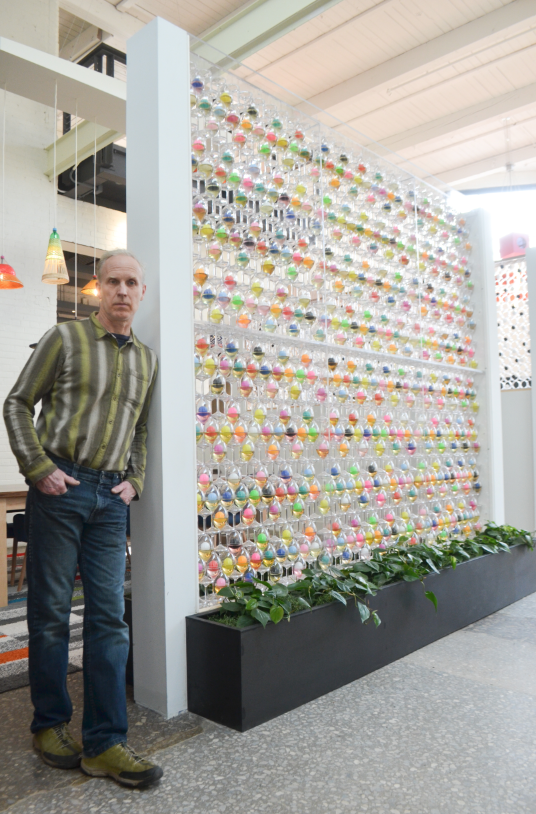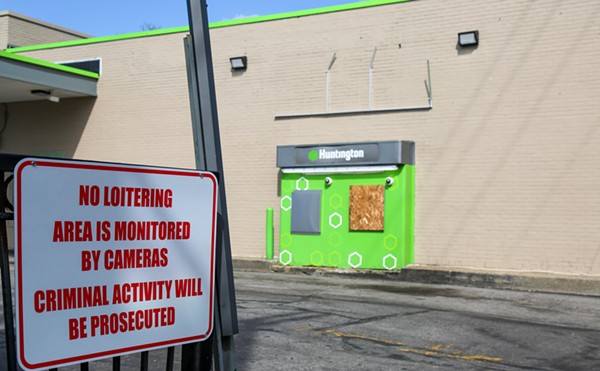Local Artist Edward A. Raffel Executes Exhilarating Conceptual Works at the New Tinnerman Lofts
By Shawn Mishak on Tue, Mar 30, 2021 at 1:40 pm
[
{
"name": "Ad - NativeInline - Injected",
"component": "38482495",
"insertPoint": "3",
"requiredCountToDisplay": "5"
},{
"name": "Real 1 Player (r2) - Inline",
"component": "38482494",
"insertPoint": "2/3",
"requiredCountToDisplay": "9"
}
]
Born in Chicago but raised in Akron, prolific artist Edward A. Raffel was commissioned to conceptualize a significant amount of artwork in the common area of the new 51-unit Tinnerman Lofts, complementing the already interesting visual experience that is this posh communal gathering place for tenants and visitors.
One centerpiece in this room is a self-symmetrical piece called "1040 Extended.” The 8’ x 11’ room-dividing screen is one of over 100 pieces of art by more than 60 artists with multiple works included in Dalad Group’s expanding collection under the advisement of President and Principal Owner Neil Viny, who is responsible for Dalad’s 2.5 million-square-foot real estate portfolio in Northeast Ohio, and Liz Maugans, curator of the Dalad Collection displayed at both Tinnerman Lofts in Ohio City and at Worthington Yards in Cleveland’s Warehouse District.
Dalad’s model of buying and renovating industrial complexes in Cleveland and furnishing their halls and common areas with local artwork is turning heads in the development community as well as among potential renters. The concept offers artists a platform to exhibit and sell their work while injecting a sense of community and history into the complexes making them attractive to potential boarders.
"1040 Extended" is made from polycarbonate wine glasses which have part of their tops surgically reduced and then fused together atop one another. The glasses are filled with assorted colors of resin to resemble different types of wine or champagne. A multitude of varying colors of ping-pong balls in a calculative arrangement were carefully selected and placed inside the glasses. The visual orchestra of triangulation and variation seduces the viewer’s eyes to dance delicately between the visual stimuli like a honey bee bouncing nimbly from one flower to the next. When the light pours through the skylight just right, the piece has a prism-like luminescence complementing the playful, two story lounge.
It is called “1040 Extended” because there are 1,040 wine glasses and was such a labor-intensive and time-consuming project to take on to achieve its stunning effect. Raffel and his studio assistant, Fei Duan, calculated roughly 50,000 procedures and 1,600 man hours in this monumental undertaking.
“The glasses piece came about because when Neil was at my house he liked a built-in mirror box piece with around 540 tiny plastic party favor champagne glasses in a self-symmetric arrangement entitled 'Perpetual Addiction, tiny bubbles version,'” explains 62-year-old Raffel. “They needed an 8’ by 11’ room dividing screen so I offered to make a life-size version with real wine glasses (polycarbonate), not realizing how long it would take.“
The tops of the glasses were used to make another, smaller screen including black and white ping-pong balls arranged in a predetermined order and displayed adjacent to "1040 Extended" in aim to balance off the vivid color of the other screen with something more subdued. This is called "Googly Eyes," because it reminded the artist of those plastic eyes with floating pupils one might find in a craft store.
Raffel is a self-described autodidact who is proficient at a number of things including jewelry making (mostly lost wax casting), sewing and tailoring, painting, drawing, interior design, space planning, architecture and sculpting. He is fairly well-versed in materials like wood, metal, plastics, but says he can't weld “yet.” Construction-wise he can do framing, finish carpentry, cabinet making, electrical work, gas lines and pipe fitting, plumbing (rough and finish), HVAC work, tiling and hardwood floor installation and refinishing, basic masonry work, drywall work and painting.
This might seem like an impressive resume in itself for any one prolific individual, but on top this myriad of skill-sets somehow, not-surprisingly, Raffel practiced dentistry for 17 years. His exacting nature is ever-present in his works, which one can assess take an incredible amount of skill, time and foresight.
“I have always been very fussy and meticulous regarding anything I did, even from a very early age (5),” says Raffel. “My bad mental health even made this worse as my perfectionism really became almost an illness. I would spend over an hour on one filling, driving my patients crazy and insuring I would make no money. If anything I did wasn't perfect I used to berate myself in an abusive way.”
One of the most technically innovative and surprising pieces among the many of Raffel’s displayed at Tinnerman is a diorama called "Tiny Disco with Plus-Plus Painting," encapsulated in a wall of the common area behind a brass-plated peephole next to another sound hole where tiny dancing figurines, a real disco ball and a miniature guitar on a miniscule stage, all painstakingly constructed by the artist, dazzle the childish curiosity of the viewer.
There is a rotation of popular dance songs playing out of another unassuming hole in the wall abreast of the peephole. The sound and lights are triggered by a magnetic reed switch when sliding the peephole cover. It is a wild surprise for any viewer curious enough to take a peek into this inconspicuous portal.
“Everything has beauty in it, so it doesn't take much for me,” says Raffel. “A little piece of junk could do it. I switched to sculpture after renting a studio in the Left Bank building in the flats and found some boxes of old stamping that became my first sculpture, a minimalistic pattern piece called 'Gear Shroud Monolith.' I became interested in minimalism after many discussions with Rob Gibbons and also Joe Fruce, a sculptor friend. Regarding artist statements, I always thought there were primarily after-the-fact bullshit that tried to make the work sound 'deep' or important. Conceptual work does need to be explained sometimes but if the viewer reads it first it completely eliminates any chance of them using their own intelligence to figure it out. Granted that is a smaller percentage of folks, but it kind of takes the fun/challenge out of it. Process-wise, sometimes I get ideas then make the product based on the concept, otherwise I just look at my junk and see what I can make out of it. It has to be beautiful though, at least to me.”
One centerpiece in this room is a self-symmetrical piece called "1040 Extended.” The 8’ x 11’ room-dividing screen is one of over 100 pieces of art by more than 60 artists with multiple works included in Dalad Group’s expanding collection under the advisement of President and Principal Owner Neil Viny, who is responsible for Dalad’s 2.5 million-square-foot real estate portfolio in Northeast Ohio, and Liz Maugans, curator of the Dalad Collection displayed at both Tinnerman Lofts in Ohio City and at Worthington Yards in Cleveland’s Warehouse District.
Dalad’s model of buying and renovating industrial complexes in Cleveland and furnishing their halls and common areas with local artwork is turning heads in the development community as well as among potential renters. The concept offers artists a platform to exhibit and sell their work while injecting a sense of community and history into the complexes making them attractive to potential boarders.
"1040 Extended" is made from polycarbonate wine glasses which have part of their tops surgically reduced and then fused together atop one another. The glasses are filled with assorted colors of resin to resemble different types of wine or champagne. A multitude of varying colors of ping-pong balls in a calculative arrangement were carefully selected and placed inside the glasses. The visual orchestra of triangulation and variation seduces the viewer’s eyes to dance delicately between the visual stimuli like a honey bee bouncing nimbly from one flower to the next. When the light pours through the skylight just right, the piece has a prism-like luminescence complementing the playful, two story lounge.
It is called “1040 Extended” because there are 1,040 wine glasses and was such a labor-intensive and time-consuming project to take on to achieve its stunning effect. Raffel and his studio assistant, Fei Duan, calculated roughly 50,000 procedures and 1,600 man hours in this monumental undertaking.
“The glasses piece came about because when Neil was at my house he liked a built-in mirror box piece with around 540 tiny plastic party favor champagne glasses in a self-symmetric arrangement entitled 'Perpetual Addiction, tiny bubbles version,'” explains 62-year-old Raffel. “They needed an 8’ by 11’ room dividing screen so I offered to make a life-size version with real wine glasses (polycarbonate), not realizing how long it would take.“
The tops of the glasses were used to make another, smaller screen including black and white ping-pong balls arranged in a predetermined order and displayed adjacent to "1040 Extended" in aim to balance off the vivid color of the other screen with something more subdued. This is called "Googly Eyes," because it reminded the artist of those plastic eyes with floating pupils one might find in a craft store.
Raffel is a self-described autodidact who is proficient at a number of things including jewelry making (mostly lost wax casting), sewing and tailoring, painting, drawing, interior design, space planning, architecture and sculpting. He is fairly well-versed in materials like wood, metal, plastics, but says he can't weld “yet.” Construction-wise he can do framing, finish carpentry, cabinet making, electrical work, gas lines and pipe fitting, plumbing (rough and finish), HVAC work, tiling and hardwood floor installation and refinishing, basic masonry work, drywall work and painting.
This might seem like an impressive resume in itself for any one prolific individual, but on top this myriad of skill-sets somehow, not-surprisingly, Raffel practiced dentistry for 17 years. His exacting nature is ever-present in his works, which one can assess take an incredible amount of skill, time and foresight.
“I have always been very fussy and meticulous regarding anything I did, even from a very early age (5),” says Raffel. “My bad mental health even made this worse as my perfectionism really became almost an illness. I would spend over an hour on one filling, driving my patients crazy and insuring I would make no money. If anything I did wasn't perfect I used to berate myself in an abusive way.”
One of the most technically innovative and surprising pieces among the many of Raffel’s displayed at Tinnerman is a diorama called "Tiny Disco with Plus-Plus Painting," encapsulated in a wall of the common area behind a brass-plated peephole next to another sound hole where tiny dancing figurines, a real disco ball and a miniature guitar on a miniscule stage, all painstakingly constructed by the artist, dazzle the childish curiosity of the viewer.
There is a rotation of popular dance songs playing out of another unassuming hole in the wall abreast of the peephole. The sound and lights are triggered by a magnetic reed switch when sliding the peephole cover. It is a wild surprise for any viewer curious enough to take a peek into this inconspicuous portal.
“Everything has beauty in it, so it doesn't take much for me,” says Raffel. “A little piece of junk could do it. I switched to sculpture after renting a studio in the Left Bank building in the flats and found some boxes of old stamping that became my first sculpture, a minimalistic pattern piece called 'Gear Shroud Monolith.' I became interested in minimalism after many discussions with Rob Gibbons and also Joe Fruce, a sculptor friend. Regarding artist statements, I always thought there were primarily after-the-fact bullshit that tried to make the work sound 'deep' or important. Conceptual work does need to be explained sometimes but if the viewer reads it first it completely eliminates any chance of them using their own intelligence to figure it out. Granted that is a smaller percentage of folks, but it kind of takes the fun/challenge out of it. Process-wise, sometimes I get ideas then make the product based on the concept, otherwise I just look at my junk and see what I can make out of it. It has to be beautiful though, at least to me.”
Tags:
SCENE Supporters make it possible to tell the Cleveland stories you won’t find elsewhere.
Become a supporter today.
Scroll to read more Cleveland News articles
Newsletters
Join Cleveland Scene Newsletters
Subscribe now to get the latest news delivered right to your inbox.














